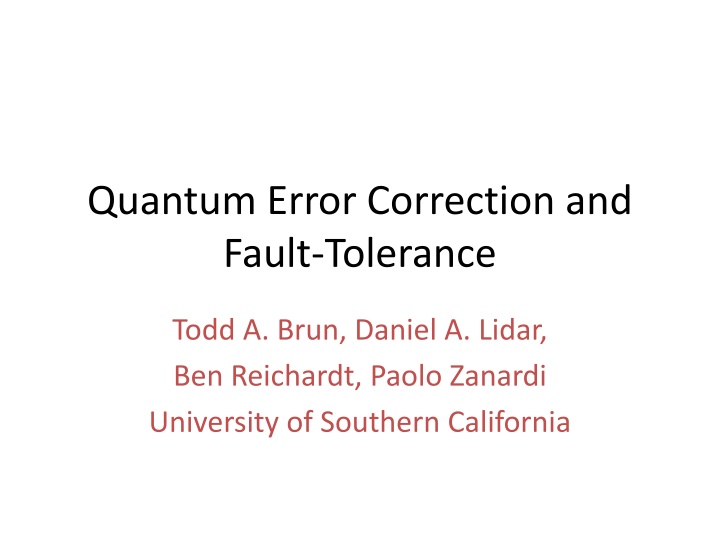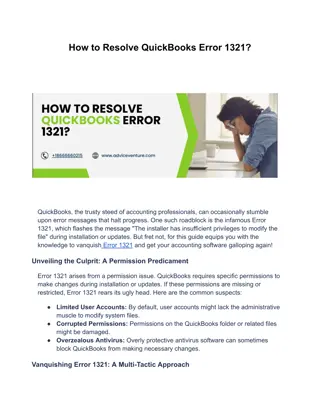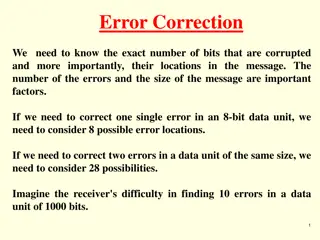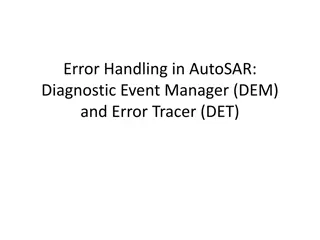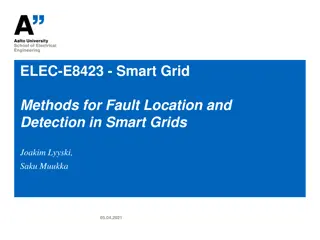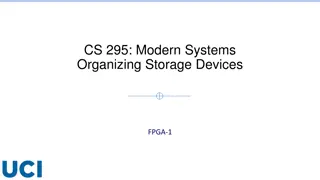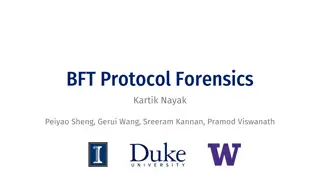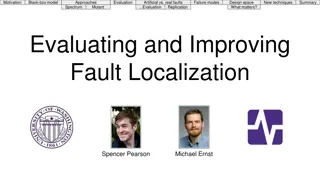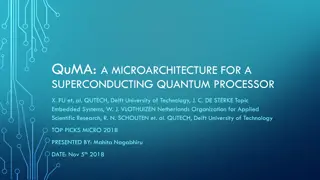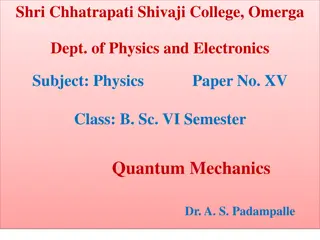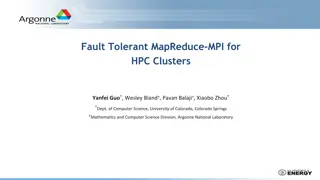Quantum Error Correction and Fault Tolerance Overview
Quantum error correction and fault tolerance are essential for realizing quantum computers due to the challenge of decoherence. Various approaches, including concatenated quantum error correcting codes and topological codes like the surface code, are being studied for fault-tolerant quantum computing. Multi-qubit block codes, processor arrays, codes with universal transversal sets, and fault-tolerant holonomic quantum computing offer promising methods to overcome challenges in quantum computation.
Download Presentation

Please find below an Image/Link to download the presentation.
The content on the website is provided AS IS for your information and personal use only. It may not be sold, licensed, or shared on other websites without obtaining consent from the author.If you encounter any issues during the download, it is possible that the publisher has removed the file from their server.
You are allowed to download the files provided on this website for personal or commercial use, subject to the condition that they are used lawfully. All files are the property of their respective owners.
The content on the website is provided AS IS for your information and personal use only. It may not be sold, licensed, or shared on other websites without obtaining consent from the author.
E N D
Presentation Transcript
Quantum Error Correction and Fault-Tolerance Todd A. Brun, Daniel A. Lidar, Ben Reichardt, Paolo Zanardi University of Southern California
The key to quantum computation The most serious obstacle to realizing quantum computers is decoherence. For almost all plausible physical systems, the same coupling to the outside world that allows controlled unitary evolution opens the system up to noise. Quantum information must therefore be protected by quantum error correction; and errors must be contained by fault-tolerant design.
The most widely studied approaches to fault- tolerant quantum computing (FTQC) use either concatenated quantum error correcting codes (QECCs) or topological codes (TCs), such as the surface code. Here we look briefly at some additional approaches that we believe are highly promising, and may overcome some of the shortcomings of other methods.
Multi-qubit Block Codes 1. When not being processed, logical qubits are stored in [[n,k,d]] block codes. These codes are corrected by repeatedly measuring the stabilizer generators via Steane extraction. 2. Logical Clifford gates can be done by measuring sequences of logical operators. This is also done by Steane extraction with a modified ancilla state. 3. A non-Clifford gate is done by teleporting the selected logical qubits into the processor block, and teleporting back after the gate. Teleportation is also used between storage blocks. 4. The processor blocks use codes that allow transversal circuits for the encoded gates. E.g., for the T gate we could use the concatenated [[15,1,3]] shortened Reed-Muller code. 5. Logical teleportation is also done by measuring a sequence of logical operators. Brun, Zheng, Hsu, Job and Lai, in preparation.
Outline of the scheme M M M P P M M M P P Processor Array Memory Array Ap Am Am Am Ap Ancilla Factory ...... ......
Codes with universal transversal sets Normally codes do not allow a complete universal set of gates to be performed transversally. Universality requires additional resources (e.g., magic state distillation). However, one can find pairs of operator codes, one of which allows transversal Hadamard gates and one T gates, in which one can transform back and forth between them by measuring syndrome generators. (E.g., 3D color codes.) Paetznick and Reichardt
Fault-tolerant Holonomic QC In Holonomic QC, the computer is always in the ground state of a Hamiltonian. Quantum gates are done by adiabatically deforming the Hamiltonian, exploiting holonomies of the ground space family. These schemes can be made fault-tolerant by combining with a QECC. Extensions can be made to nonadiabatic evolutions, and solutions that combine topological and holonomic robustness.
E.g., We can do HQC in surface codes. ( a ) ( b ) ( c ) } Z-cut ZL1 { ZL1 ZL2 ZL2 X-cut ( d ) ( e ) ( f ) ZL XL1 XL2 Z =Z Z L2 ZL1 L1 L2
Stabilization and error suppression It is also possible to suppress the effects of errors under certain circumstances. For example, noise processes with intrinsic symmetries may allow decoherence-free subspaces or noiseless subsystems. In some cases, the effects of noise can be undone or canceled, for instance by dynamical decoupling.
Dissipation-Assisted Quantum Information Processing Paolo Zanardi and Daniel A. Lidar
Dissipation-Assisted Quantum Information Processing Paolo Zanardi & Daniel Lidar (USC) Traditional View Dissipative dynamics: quantum coherence/entanglement Are (typically & quickly) Destroyed = Worst enemy of QIP Fight with: quantum error correction, decoherence-free (DFS) Subspaces, dynamical-decoupling, topological-geometric QIP, Novel View Dissipative dynamics can be harnessed & exploited to the end of QIP: pure-state preparation, quantum computation, quantum simulations Our Strategy is based on P. Zanardi, L. Campos Venuti, Phys. Rev. Lett. 113, 240406 (2014)
Projection Theorem: small Hamiltonian controls gets Zeno-projected and Renormalized by strong dissipation and give rise to an effective unitary dynamics over the Steady State Manifold (SSM) of the system Coherent holonomic (geometric) manipulations in the SSM Complexity, (non) locality and robustness can be enhanced We have shown dissipation-assisted gates in DFSs and NSs Unitary dynamics can emerge out of purely dissipative one Moral: dissipation & decoherence can be good guys and DOE should not forget about that! Thanks Todd!
Error Correction in Quantum Annealing and Adiabatic QC
Quantum Annealing Correction Strategy 1. Encode into repetition code: 2. Add energy penalty: 3. Combine: penalty scale (optimized) 4. Run QA: 5. decode at end by majority vote
Quantum Annealing Correction works K. Pudenz, T. Albash, D.A. Lidar, Nature Comm. 5, 3243 (2014) best of 4 chains run in parallel penalty + majority voting on encoded qubits =0.3
Also random Ising problems benefit [arXiv:1408.4382] number of repetitions to find solution at least once =0.5 The advantage gained from QAC is larger for larger and harder problems
Estimated Performance of Storage Blocks [[2047,23,63]] (blue), [[2921,57,77]] (red), and [[5865,143,105]] (green). These curves are generated by Monte Carlo simulations and linear extrapolation. However, the extrapolation at low error rates can be backed up by an upper bound calculated purely from the distances of the code. For peff = 0.007, we get bounds on the error rates of approximately 10-16, 2.5x10-19, and 7x10-24.
Estimated Performance of Processor Blocks The [[15,1,3]] code at two (blue) and three (red) levels of concatenation. A combination of Monte Carlo simulations at higher errors, a rough bound at lower errors, and (not to be relied upon) extrapolation. At peff = 0.007 (all contributing error processes below 5x10-4), the block error rate is estimated to be roughly 2x10-12. This is certainly small enough to carry out highly nontrivial quantum computations.
